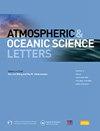Evaluating vector winds over eastern China in 2022 predicted by the CMA-MESO model and ECMWF forecast
IF 3.2
4区 地球科学
Q3 METEOROLOGY & ATMOSPHERIC SCIENCES
引用次数: 0
Abstract
Vector winds play a crucial role in weather and climate, as well as the effective utilization of wind energy resources. However, limited research has been conducted on treating the wind field as a vector field in the evaluation of numerical weather prediction models. In this study, the authors treat vector winds as a whole by employing a vector field evaluation method, and evaluate the mesoscale model of the China Meteorological Administration (CMA-MESO) and ECMWF forecast, with reference to ERA5 reanalysis, in terms of multiple aspects of vector winds over eastern China in 2022. The results show that the ECMWF forecast is superior to CMA-MESO in predicting the spatial distribution and intensity of 10-m vector winds. Both models overestimate the wind speed in East China, and CMA-MESO overestimates the wind speed to a greater extent. The forecasting skill of the vector wind field in both models decreases with increasing lead time. The forecasting skill of CMA-MESO fluctuates more and decreases faster than that of the ECMWF forecast. There is a significant negative correlation between the model vector wind forecasting skill and terrain height. This study provides a scientific evaluation of the local application of vector wind forecasts of the CMA-MESO model and ECMWF forecast.
摘要
本文利用矢量场评估VFE方法, 从矢量场角度系统性评估CMA-MESO模式与ECMWF模式对2022年华东地区10 m高度矢量风场的预报技巧. 结果表明, ECMWF模式对矢量风场空间分布与风场强度的预报均优于CMA-MESO模式. CMA-MESO模式明显高估了矢量风场的强度. 模式预报技巧随着预报时效的延长而下降, 其中以CMA-MESO模式的预报技巧波动更大, 衰减更迅速. 本研究将为CMA-MESO模式与ECMWF模式风场预报产品的本地化应用, 提供一个科学的评估依据.

CMA-MESO模式和ECMWF预测的2022年中国东部矢量风的评价
矢量风在天气和气候中起着至关重要的作用,也是风能资源的有效利用。然而,将风场作为矢量场来评价数值天气预报模式的研究却很少。本研究采用矢量场评价方法,将矢量风作为一个整体,结合ERA5再分析,对中国气象局(CMA-MESO)中尺度模式和ECMWF预报的2022年中国东部矢量风的多个方面进行了评价。结果表明,ECMWF预报在10 m矢量风的空间分布和强度预测上优于CMA-MESO预报。两种模式均高估了华东地区的风速,CMA-MESO高估的程度更大。两种模式对矢量风场的预测能力均随提前时间的增加而降低。CMA-MESO预报能力比ECMWF预报能力波动大,下降快。模式矢量风预报技能与地形高度呈显著负相关。本研究对CMA-MESO模式和ECMWF预报的矢量风预报在局部应用进行了科学评价。摘要本文利用矢量场评估VFE方法,从矢量场角度系统性评估CMA-MESO模式与ECMWF模式对2022年华东地区10米高度矢量风场的预报技巧。“”“”“”“”“”“”“”“”“”“”“”这是一个很好的例子。模式预报技巧随着预报时效的延长而下降,其中以CMA-MESO模式的预报技巧波动更大,衰减更迅速。“”“”“”“”“”“”“”
本文章由计算机程序翻译,如有差异,请以英文原文为准。
求助全文
约1分钟内获得全文
求助全文
来源期刊

Atmospheric and Oceanic Science Letters
METEOROLOGY & ATMOSPHERIC SCIENCES-
CiteScore
4.20
自引率
8.70%
发文量
925
审稿时长
12 weeks
 求助内容:
求助内容: 应助结果提醒方式:
应助结果提醒方式:


